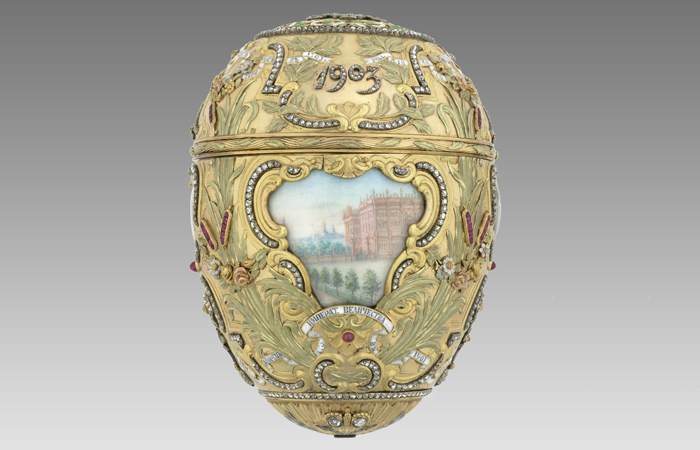Russian treasures reinstalled in renovated galleries named for Eda Hofstead Cabaniss
The Virginia Museum of Fine Arts’ renowned Fabergé collection is returning from an international tour, and will be displayed in a new suite of renovated galleries opening to the public on October 22, 2016. The new installation will feature 280 objects– composed of Fabergé and other Russian decorative arts– in a multi-layered interactive experience. VMFA will be the only American art museum with five galleries dedicated to Fabergé and other Russian objects.
VMFA’s holdings comprise the largest art museum collection of Fabergé and Russian objects outside of Russia. The collection includes five of the 52 Russian Imperial Easter Eggs created by the Fabergé firm led by jeweler Karl Fabergé. Most objects by Fabergé are made from hardstones, precious metals, including gold, platinum, and silver, as well as diamonds, gemstones, and other materials. The newly redesigned space will allow a view of each Imperial Egg in the round. Organized by material, the five galleries include sections that feature objects of gold and silver, jewelry, enamels, hardstones, icons, and an Old Russian style table with hammered-brass panels never before displayed in a museum. The suite’s three central Fabergé galleries are named in honor of Eda Hofstead Cabaniss, a former VMFA Foundation Board member and generous patron of the museum.
“Our Fabergé and Russian decorative arts collection is a longtime visitor favorite,” VMFA Director Alex Nyerges said, “and we are thrilled to be reinstalling it this year in a larger modern space. The Fabergé collection has traveled the globe and is coming home to a suite of galleries that boast digital components, which will allow visitors to engage with the art in new and dynamic ways.”
Redesigned with a focus on interactive components, the suite will feature four large touchscreens allowing visitors to view the intricate construction of the five Imperial Eggs as they open and reveal their interiors. After viewing the collection of the Fabergé miniature Easter eggs, visitors can create and share their own design on an interactive application that will be featured discretely throughout the galleries. The mobile application will also bring to life the rich fairytales featured on various decorative objects and provide an in-depth, historical experience that narrates and enriches the entire Fabergé collection.
VMFA Fabergé and Russian Decorative Arts At-A-Glance
- Opens October 22, 2016
- Largest public collection of Fabergé objects outside of Russia
- Includes 5 of the 14 Imperial Easter Eggs in the United States by the Fabergé firm
- 5 new galleries measuring a total of 1,963 sq. ft. and featuring 280 objects
- 167 creations from the Fabergé firm
- Generous support for the new Fabergé and Russian Decorative Arts Galleries has been provided by Eda Hofstead Cabaniss, the Commonwealth of Virginia,
- and The Council of the Virginia Museum of Fine Arts.
Lillian Thomas Pratt
VMFA has 190 objects by or attributed to the Fabergé firm, including five of the 14 Imperial Easter Eggs now in the U.S. Almost 170 of these treasures are from the Lillian Thomas Pratt Collection of Fabergé and Russian Decorative Arts, which is the largest public group of Fabergé Imperial Easter Eggs outside Russia. The collection was formed by Mrs. Lillian Thomas Pratt of Fredericksburg, Va., between 1933 and 1946 and comprises more than 400 pieces of Russian decorative arts. Mrs. Pratt, the wife of General Motors executive John Lee Pratt, bequeathed the collection to VMFA in 1947.
About Karl Fabergé
Karl Fabergé’s firm, arguably the most famous jewelry establishment of all time, created objects for Tsar Alexander III and Tsar Nicholas II, along with their families and much of European nobility. Karl Fabergé is best known for his Imperial Easter Eggs.
Born in 1846, this highly distinguished artist and entrepreneur took over the family business from his father, the jeweler Gustav Fabergé, in the 1870s. Initially the firm created jewelry, however, when Fabergé was appointed Supplier to the Imperial Crown, he began his series of 52 Imperial Easter Eggs, which established his enduring fame. Empress Maria Feodorovna, wife of Tsar Alexander III, received 30 of these celebrated masterpieces. Her daughter-in-law, later Tsarina Alexandra Feodorovna, wife of Nicholas II, the last tsar, received 20 Imperial Eggs. Two additional eggs were planned and partially created for Easter 1917, but Nicholas abdicated before they were finished and delivered.
Fabergé’s firm, with 500 craftsmen and five branch offices, produced more than 150,000 pieces of jewelry, silver, and precious objects. Many of the objects were disassembled, melted, or destroyed during the 1917 Revolution. After the execution of Tsar Nicholas II and his family, Fabergé closed his shops, fled, and died as a refugee in Switzerland in 1920.
About the Virginia Museum of Fine Arts
VMFA’s permanent collection encompasses more than 35,000 works of art spanning 5,000 years of world history. Its collections of Art Nouveau and Art Deco, English silver, Fabergé, and the art of South Asia are among the finest in the nation. With acclaimed holdings in American, British Sporting, Impressionist and Post-Impressionist, and Modern and Contemporary art – and additional strengths in African, Ancient, East Asian, and European – VMFA ranks as one of the top comprehensive art museums in the United States. Programs include educational activities and studio classes for all ages, plus lively after-hours events. VMFA’s Statewide Partnership program includes traveling exhibitions, artist and teacher workshops, and lectures across the Commonwealth. VMFA, a certified Virginia Green attraction, is open 365 days a year and general admission is always free. For additional information, telephone 804-340-1400 or visit www.vmfa.museum.
# # #
Press Contacts:
Sam Campbell, sam.campbell@vmfa.museum, 804-204-2770
Allan Altholz, allan.altholz@vmfa.museum 804-204-2721
Virginia Museum of Fine Arts, 200 N. Boulevard, Richmond VA 23220-4007
Image Credit:
Imperial Peter the Great Easter Egg, 1903, gold, platinum, diamonds, rubies, sapphire, enamel, rock crystal, watercolor on ivory, 4.25 x 3.125 (diameter) in. (10.80 x 7.94 (diameter) cm). Bequest of Lillian Thomas Pratt, 47.20.33
